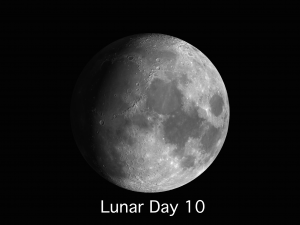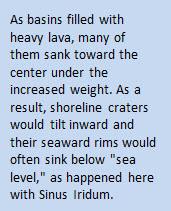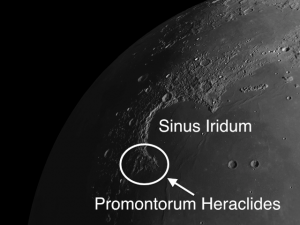 The week of May 16-22 takes us from lunar Day 10 through Day 16. Because the full Moon is on Saturday, May 21st, the Moon will be very bright for most of the week. This week we will highlight Sinus Iridum on the NW shore of Mare Imbrium.
The week of May 16-22 takes us from lunar Day 10 through Day 16. Because the full Moon is on Saturday, May 21st, the Moon will be very bright for most of the week. This week we will highlight Sinus Iridum on the NW shore of Mare Imbrium.
• Sinus Iridum: [NW/E6] Sinus Iridum (the Bay of Rainbows), located in the northwest sector of Mare Imbrium, formed after the Imbrium impact but before the lava flooding that filled the Imbrium basin. This bay is itself an enormous 160-mile crater and is the largest and most spectacular example of subsidence on the Moon. If you have very sharp eyes, without optical aid you should be able to see the “bite” that Iridum takes out of Mare Imbrium. (You may have to wait until Tuesday night.)

 When the Sun is at a low angle, you can see that Sinus Iridum is covered with wrinkle ridges like so many waves lapping toward the shore.
When the Sun is at a low angle, you can see that Sinus Iridum is covered with wrinkle ridges like so many waves lapping toward the shore.
The Jura Mountains, on the rim of Sinus Iridum, curve protectively around the bay and descend, because of the above-mentioned subsidence, to sea level where they terminate in capes at each end: Promontorium Laplace on the northeast, and Promontorium Heraclides on the southwest.
Pay close attention to Promontorium Heraclides. Under the right lighting conditions around Day 10 (Monday) you can see the profile of a woman’s head with long flowing hair as she gazes wistfully out into the bay. Those who have gotten to know her refer to her fondly as the Moon Maiden. Cassini himself was the first person to describe this feature. She reveals herself best when the seeing is a bit “soft” and the terminator has just cleared the western edge of the Jura Mountains (around longitude 34°W). At this time you will see her gazing across the bay to Promontorium Laplace, her hair streaming out behind her. If the seeing is crisp, try defocusing a little.
OF ADDITIONAL INTEREST ON LUNAR DAY 10 THROUGH DAY 16:
The big news for this week is that Mars will reach opposition on Sunday, May 22nd; i.e., it will be opposite the Sun and high in the sky, and it will transit at 1:00 AM in your time zone on that date. This means that Mars will be at its closest point to the Earth for the next two years, and it is at its biggest and brightest in more than a decade! Its apparent size will be 18.4 arc-seconds (as opposed to a paltry ~3.5 arc-seconds when it is farthest away). This is your best opportunity to see features on Mars. For a great program to see what features are visible for any date and time go to: http://www.skyandtelescope.com/observing/interactive-sky-watching-tools/
Several extremely valuable tools are provided on this page by Sky and Telescope. Click away on the ones that interest you.
Jupiter is well-positioned in Leo for evening observing through July.
On Friday at 11:30 PM in your time zone, the Moon, Mars, and Saturn will be in the same close neighborhood over the southern horizon. Saturn is always a show-stopper, and you only need a magnification of 30x or more to see its rings and some of the moons.
======================
It is highly recommended that you get a copy of Sky and Telescope’s Field Map of the Moon, the very finest Moon map available for use at the telescope. It is available for $10.95 at www.skyandtelescope.com and on Amazon. All features mentioned in this blog will be keyed to the grid on the Field Map and will look like this: Plato: [NW/D9]
Credits:
Courtesy of Gray Photography of Corpus Christi, Texas
Lunar photos: NASA / USGS / BMDO / LROC / ASU / DLR / LOLA / Moon Globe. Used by permission
- Rupes Cauchy: A Best Known Fault on the Moon - July 22, 2024
- Moon Crater Schickard – Crater Floor has Stripes - July 15, 2024
- Moon Craters Langrenus and Vandelinus - July 8, 2024